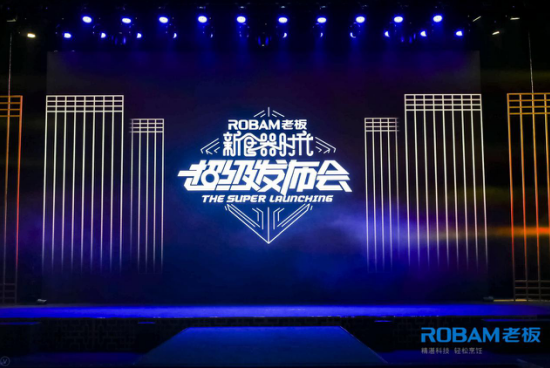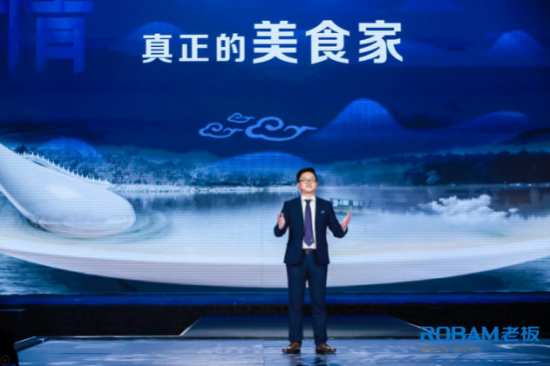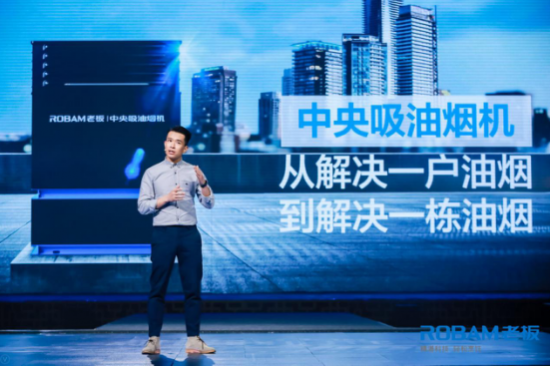"The people take food for the day, and the words take the food first." The word "food" has always held a special place in Chinese culture, from ancient rituals to sacred traditions and even the walls of the Xiao. It's no surprise that eating is deeply rooted in the hearts of the Chinese. Traditional Chinese culinary culture is rich and profound, and as time moves forward, it continues to evolve quietly.
On March 7th, Boss Electric unveiled its latest innovations at Shenzhen Satellite TV's "Super Release Conference." The event took place at the Grand View Stage in Shanghai Zendai Himalaya Art Center, where the company introduced three new products and launched the "New Food Age." This initiative aims to bring new life to traditional culinary culture through technology. By combining science and tradition, Boss Electric enhances the charm of kitchen appliances while preserving the essence of Chinese food culture. The brand is now opening the "New Food Era," empowering the modern Chinese with both "food" and "devices." Based on this vision, Boss Electric proposed the idea of "Creating a New Kitchen in China," using technological innovation and deep insights into traditional culinary practices and contemporary lifestyles to redefine the modern kitchen.
As the fifth episode of the "Super Release" series, the conference explored the concept of "Good Food" through three chapters: "Human Fireworks," "Return to the Steam," and "Net Enjoy the Future." It encouraged busy city dwellers to return to the kitchen and enjoy the joy of cooking, the safety of healthy meals, and the warmth of love. The show will air on Shenzhen Satellite TV at 20:30 on March 11th.

Food: The Evolution and Legacy of Chinese Culinary Culture
A core characteristic of Chinese traditional food culture is its deep emotional and social significance. Food is more than just nourishment—it’s a medium for connection, a symbol of family bonds, and a way to express love and care. Whether in ancient times or today, this role remains unchanged.
At the Super Launch Conference of the "New Food Age," Xiong Taihang, an app columnist and author of "Relationship Raiders," delivered a speech highlighting how "there are feelings too difficult to express in words, but can be conveyed through cooking." Yu Dingyong, known as the male chef of the 80s style, shared his personal experiences. As a father, he emphasized how cooking is the emotional glue that binds families together. He also talked about how he tries to discover his children's taste buds and provide them with a balanced diet through cooking.
As society changes, the ways in which Chinese people express their emotions have become more open and simple. Kitchens, once private spaces, are now more accessible. Yet, food still plays a central role in maintaining relationships. Boss Electric aims to make kitchen life more convenient and enjoyable through its innovative products, making cooking easier and creating a warm, joyful dining experience for everyone.

Photo: Xiong Taixing explains Chinese diet and relationships
Reviving Traditional Culinary Culture Through Technology
To ensure the continuity of traditional food culture, it must be given a new form that resonates with modern audiences. The theme of the conference, "New Food Age," reflects Boss Electric’s vision of integrating traditional Chinese food culture with modern kitchen appliance design.
With 39 years of experience in high-end kitchen appliances, Boss Electric has developed a unique approach to the "Chineseization" of kitchen products. This goes beyond adapting technology to match local cooking habits—it also involves respecting and incorporating traditional culinary values into product design.
In the era of consumption upgrades, Chinese eating habits and culinary culture are evolving. More people are shifting toward healthier, organic diets, and Boss Electric’s new products reflect this trend. The dual-vent pressure range hood reduces smoke, creating a cleaner cooking environment. The top three-core steamer preserves flavors and makes steaming faster and more efficient. The professional pesticide residue purification tank effectively removes harmful substances from ingredients, offering a complete kitchen cleaning solution with a dedicated sink, dishwasher, and water purifier.
Boss Electric also introduced a revolutionary product—the central range hood. With over 4 billion cubic meters of smoke emitted daily in Chinese kitchens, the central range hood addresses this issue by purifying air before it is released. Equipped with an 8000 cubic meter fan and purification module, it achieves over 90% efficiency in removing pollutants. This innovation not only transforms the function of the range hood but also demonstrates Boss Electric’s commitment to environmental sustainability and public health.

Picture: CTO Wang Qiang introduces the central range hood
Throughout the conference, Boss Electric’s new products and ideas clearly showed one message: the brand is not just an industry leader in kitchen appliances, but also a cultural ambassador, spreading the richness of Chinese food culture around the world.
Directional antennas are a vital component in wireless communication systems, renowned for their ability to transmit and receive signals with a high degree of directionality. These antennas are designed to focus their radiation pattern in a specific direction, enhancing the signal strength in that direction while minimizing interference and noise in other directions. Directional antennas come in various shapes, sizes, and configurations, each tailored to meet specific communication requirements. In this article, we will delve into the classification and key features of directional antennas.
Classification of Directional Antennas
-
Beamwidth and Gain
- Narrow Beamwidth Antennas: These antennas have a narrow radiation pattern, resulting in a high gain in a specific direction. They are ideal for long-distance communication and applications requiring high directionality, such as satellite communication, point-to-point microwave links, and radar systems.
- Medium Beamwidth Antennas: Offering a balance between gain and coverage, medium beamwidth antennas are commonly used in cellular networks, Wi-Fi access points, and other applications where a balance of range and coverage area is crucial.
- Wide Beamwidth Antennas: With a wider radiation pattern, these antennas provide broader coverage but with lower gain. They are suitable for applications where wide-area coverage is essential, such as TV broadcasting, emergency communication systems, and some types of IoT networks.
-
Polarization
- Linearly Polarized Antennas: These antennas radiate energy with a linear polarization, either horizontally or vertically. They are commonly used in terrestrial communication systems due to their compatibility with most transmitting and receiving equipment.
- Circularly Polarized Antennas: Circular polarization occurs when the electric field vector rotates in a circular or elliptical path as the wave propagates. Circularly polarized antennas are ideal for satellite communication and applications involving moving receivers, as they maintain signal integrity even when the antenna's orientation changes.
-
Array Configuration
- Yagi-Uda Antennas: A popular type of directional antenna, Yagi-Uda antennas consist of a driven element and multiple parasitic elements. They offer high gain and directionality, making them suitable for long-distance communication and television broadcasting.
- Parabolic Dish Antennas: As discussed earlier, parabolic dish antennas use a parabolic reflector to focus the radio waves into a narrow beam. They are commonly used in satellite communication and radar systems due to their high gain and excellent directivity.
- Panel Antennas: Sector panel antennas are flat, directional antennas designed to cover a specific sector of a circle. They are widely used in cellular networks, where multiple panel antennas are mounted on towers to provide coverage in various directions.
-
Frequency Range
- Directional antennas are available in a wide range of frequency bands, from low-frequency (LF) and medium-frequency (MF) bands used for broadcasting and marine communication to high-frequency (HF), very high-frequency (VHF), ultra-high-frequency (UHF), and microwave bands used in cellular networks, Wi-Fi, and satellite communication.
Directional Antenna WiFi,Directional Antenna TV,Directional Antenna LTE,Directional Antenna Indoor,Directional Antenna Outerdoor
Yetnorson Antenna Co., Ltd. , https://www.yetnorson.com